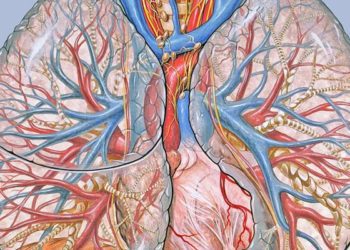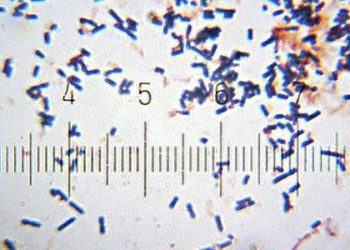2 Minute Medicine Rewind December 4, 2017
The most efficacious means of reducing recurrent clostridium difficile infection (RCDI) is by way of fecal microbiota transplantation (FMT). It is unclear, however, whether clinical efficacy varies with route of delivery, either by colonoscopy or oral capsule. In this noninferiority, unblinded, randomized controlled trial, 116 patients with evidence of RCDI were randomized to receive FMT by capsule or colonoscopy at a 1:1 ratio with 105 finishing the trial. The primary outcome of the study was the proportion of patients without RCDI 12 weeks after FMT. Researchers found that prevention of RCDI after a single treatment was achieved in 96.2% of participants in both the capsule and colonoscopy groups (difference 0%, 1-sided 95% Cl -6.1% to infinity, p<0.001), meeting the criterion for noninferiority. Secondary outcomes included serious and minor adverse events. Minor adverse events, including nausea, vomiting, abdominal pain and fevers, occurred in 5.4% of individuals in the capsule group versus 12.5% for the colonoscopy group. There was also no significant difference in improvement in quality of life between the groups. Finally, a greater proportion of individuals in the capsule group rated their experience as “not at all unpleasant” as compared to patients in the colonoscopy group (66% vs 44%; difference 22% (95% Cl 3% to 40%, p=0.01). This study therefore shows that FMT delivered via oral capsules is not inferior to delivery via colonoscopy in the prevention of RCDI.
Association Between Wait Time and 30-Day Mortality in Adults Undergoing Hip Fracture Surgery
It has been well-established that expedited hip fracture surgery is associated with improved mortality outcomes. However, controversy remains surrounding the acceptable waiting time for surgery. Both US and Canadian guidelines currently recommend surgery within 48 hours. In this population-based, retrospective cohort study, researchers used population-based wait time data to identify the optimal time window for hip fracture surgery before the risk of complications increased. Research participants included adults undergoing hip fracture surgery between April 1, 2009, and March 31, 2014, in 72 hospitals in Ontario, Canada. Researchers found that among the 42,230 patients with hip fractures (mean age (SD) 80.1 years (10.7 years), 70.5% female) overall mortality at 30 days was 7.0%. The risk of complications increased when wait times were greater than 24 hours, regardless of the complication. Compared to 13,731 propensity-score matched patients who received surgery earlier, 13, 731 patients who received surgery after 24 hours had a significantly greater risk of 30-day mortality (% absolute risk difference 0.79, 95% Cl 0.23 to1.35, p=0.006). This study therefore shows that increased wait time to hip surgery is associated with a greater risk of 30-day mortality and other complications. As the inflection point was about 24 hours, this may represent the threshold defining higher risk.
Fremanezumab for the Preventive Treatment of Chronic Migraine
Migraines can pose a significant burden on an individual’s quality of life, often leaving patients functionally impaired. A complex neurologic disorder, it has a variable presentation, but is primarily characterized by recurrent attacks of pulsating headache pain. Preventative strategies are recommended in patients with chronic migraines as part of improving quality of life. However, most treatments are underused, not adhered to, ineffective, or associated with side effects. Fremanezumab is a humanized monoclonal antibody targeting the calcitonin gene-related peptide (CGRP) involved in central and peripheral pathophysiological events of migraine. In this phase 3 randomized controlled trial, 1130 patients were randomized in a 1:1:1 ratio to receive fremanezumab quarterly (a single dose of 675 mg at baseline and placebo at weeks 4 and 8), fremanezumab monthly (675 mg at baseline and 225 mg at weeks 4 and 8), or matching placebo to evaluate the efficacy and safety of two subcutaneous dose regimens of fremanezumab for the preventive treatment of chronic migraine. Researchers found that the least-squares mean (±SE) reduction in the average number of headache days per month was 4.3±0.3 with fremanezumab quarterly, 4.6 ±0.3 with fremanezumab monthly, and 2.5±0.3 with placebo (p<0.001 for both comparisons with placebo). The percentage of patients with a reduction of at least 50% in the average number of headache days per month was 38% in the fremanezumab-quarterly group, 41% in the fremanezumab-monthly group, and 18% in the placebo group (p<0.001 for both comparisons with placebo). There were abnormalities in hepatic function in 5 patients in each of the fremanezumab groups (1%) and 3 patients in the placebo group (<1%). This study therefore shows that migraine headache frequency can be effectively reduced using fremanezumab when compared to placebo. However, further studies are needed to elucidate the long-term durability and safety of fremanezumab.
A Controlled Trial of Erenumab for Episodic Migraine
Migraines can be classified as either episodic or chronic on the basis of the number of migraine days per month. Episodic migraine is defined as fewer than 15 days with or without aura, and accounts for more than 90% of persons with migraines. Current medications such as serotonin receptor agonists (triptans) are used to abort a migraine attack. Recently, a novel drug, erenumab, that antagonizes calcitonin gene-related peptide (CGRP) receptors, has been shown to reduce episodic migraines attacks. In this randomized controlled trial, 955 patients were randomly assigned patients to receive a subcutaneous injection of erenumab, at a dose of 70 mg or 140 mg, or placebo monthly for 6 months. The primary end point was the change in mean number of migraine days per month. The mean number of migraine days per month at baseline was 8.3 in the overall population. At months 4 through 6 of follow-up, the number of migraine days per month was reduced by 3.2 in the 70 mg erenumab group and by 3.7 in the 140 mg erenumab group, as compared to 1.8 days in the placebo group (p<0.001 for each dose vs. placebo). A 50% or greater reduction in the mean number of migraine days per month was achieved in 43.3% of patients in the 70 mg erenumab group and 50.0% of patients in the 140 mg erenumab group, as compared to 26.6% in the placebo group (p<0.001 for each dose vs. placebo). The number of days of use of acute migraine-specific medication was also reduced by 1.1 days in the 70 mg erenumab group and by 1.6 days in the 140 mg erenumab group, as compared to 0.2 days in the placebo group (p<0.001 for each dose vs. placebo). Using the migraine Physical Function Impact Diary researchers also found that physical impairment scores improved by 4.2 and 4.8 points in the 70 mg and 140 mg erenumab groups, respectively, as compared to 2.4 points in the placebo group (p<0.001 for each dose vs. placebo). The rates of adverse events were similar between erenumab and placebo. Taken together, these results indicate that the use of erenumab may reduce migraine frequency and improve overall quality of life.
As survival rates have increased among cystic fibrosis (CF) patients, complications related to the disease have become more prevalent. One such complication is CF-related diabetes. While injected insulin has been recommended, some patients opt for oral antidiabetic drugs due to the treatment burden associated with insulin injection. In this multicenter randomized controlled trial 75 CF patients age 10 years and older with newly diagnosed diabetes were randomized to receive insulin or repaglinide. The primary outcome of the study was glycemic control assessed by mean change in HbA1c concentration from baseline after 24 months of treatment. Researchers found that at 24 months of follow-up, glycemic control was similar in the repaglinide and insulin groups (mean change in HbA1c concentration from baseline 0.2% (SD 0.7%), with repaglinide vs. -0.2% (SD 1.3%). The mean difference between groups was -0.4% (95% CI -1.1% to 0.2%, p=0.15). The results of this study therefore show that repaglinide may be used in achieving glycemic control in patients with CF-related diabetes, with comparable efficacy to injected insulin.
Image: PD
©2017 2 Minute Medicine, Inc. All rights reserved. No works may be reproduced without expressed written consent from 2 Minute Medicine, Inc. Inquire about licensing here. No article should be construed as medical advice and is not intended as such by the authors or by 2 Minute Medicine, Inc.







